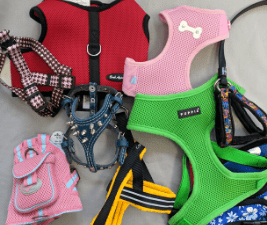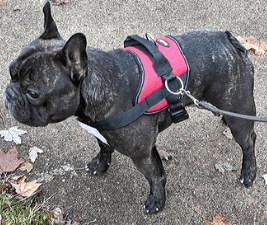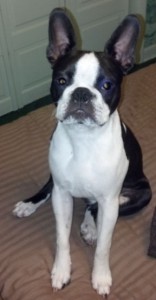It seems to be puppy season! New puppy “parents” have been asking which is better for walking their little ones, harness or collar?
The answer is easy if it’s a smaller dog. Harness, all the way. Little and toy dogs are prone to “collapsing trachea,” caused by pressure on the dog’s throat. Pressure caused by dogs wearing collars pulling on lead. A small dog may not be strong enough to hurt you by pulling, but he can do damage to himself. Collapsing trachea causes coughing and gagging. Over time, it can even impact the dog’s ability to breathe and swallow.
Collars are useful
Which is not to say that small dogs shouldn’t be accustomed to wearing collars. Having I.D. on the collar is certainly the fastest way to identify owners and get dogs back to them, should something unexpected occur. If your dog happens to get away, it’s faster when a good Samaritan finds him to call the number on the tag than go through the process of getting a microchip scanned, tracked, and contacted.
When our dogs are home, they’re usually naked. When we’re home and they’re running around the house and playing (with each other or with us), we don’t want to risk a collar or harness getting caught on anything. Same thing if we’re away. Our dogs are in their crates and naked. They’re comfortable there and we know they’re not going to chew on anything (like electrical cords) that could harm them.
The exception to the “naked at home” rule is when we’re expecting visitors, whether it’s family, friends, or some professional (plumber, electrician, delivery person, etc.) we’ve called. Just in case, the dogs are wearing their collars when we have people over. Someone could leave open a door, or a gate. Or it could blow open if not closed all the way. When you think about it, it’s true that every home has some quirks that you deal with, but no one else knows about. Like our screen door that doesn’t latch if the wind is blowing from a particular direction. No delivery person would know that.
No “everybody” harness
There’s no single harness that’s “the best” for every dog. There are so many different designs and styles that it can be confusing. But there is a best harness for every dog.

Figuring out which harness is right means you have to think about how you and your dog walk together. Does either one of you have physical limitations? That could mean anything from the “tripod” dog we fit a while ago, to having issues opening the hard, plastic clasps many harnesses feature.
Other considerations: does your dog resist the harness? Or hate having things go over her head? How is he with someone touching his feet? Does she try to back out?
Your answers will decide the kind of harness that’s right for you and your dog.
In and out of style
There are three basic types of harnesses: vest style, step-in, and standard. Each has its advantages and best uses. We’ve developed separate sub-sections in our shop to address each of the three. We also have sections for “hook and loop” style harnesses. We don’t use the trade name, for obvious reasons. Suffice it to say that when we offer an extra “Velcro” strip for use with the Wrap-N-Go, you will be getting actual Velcro material.
Over the years we’ve developed harness expertise, and we’re happy to share what we know. If you’re not sure which harness is ideal for you and your dog, please contact us! We’re more than happy to make individualized recommendations when you fill out and submit our “Harness Selector Questionnaire.”

It is possible for the “best” harness for your dog to change over time. For example, a few years ago the “no-pull” harness with the leash ring in the front was introduced. For a while, it became all the rage. Then we started hearing reports about dogs having shoulder and/or elbow issues after using them. There’s a different design for “no-pull” harnesses now – attaching the leash at the side to minimize stress on the dog’s joints, while achieving the same effect. It’s relatively new, but we’re liking what we’re seeing so far.
Ask!
If you’re not sure what to do – please ask! We want you and your dog to enjoy your walks together. We’re easy to reach and happy to help!












